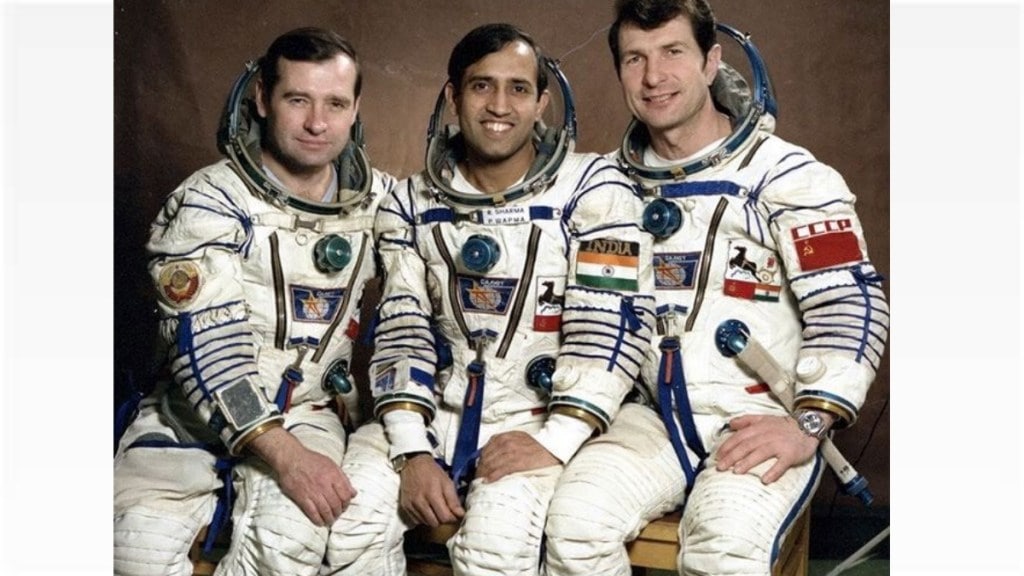Today is the 40th anniversary of Squadron Leader Rakesh Sharma’s historic flight aboard the Soviet Soyuz T-11 spacecraft. This mission was a pivotal moment, showcasing India’s early ambitions in space exploration and paving the way for its future endeavours.
Established in 1969, the Indian Space Research Organisation (ISRO) embarked on an ambitious journey. With limited resources but boundless enthusiasm, putting an Indian cosmonaut in space seemed like a distant dream. The Indo-Soviet Space Mission, born from a strong friendship between the two nations, presented a remarkable opportunity.
Selecting the right candidate was crucial. Test pilots, with their experience in complex aviation systems, were ideal choices. Wing Commander Rakesh Sharma and his colleague, Ravish Malhotra, were chosen among the huge aspirants and they had undergone rigorous training at the Institute of Aerospace Medicine in Bangalore and later in Star City, Russia.
The unwavering trust in the robust Russian technology and the meticulous training instilled confidence in the crew. Launching Aboard Soyuz T-11
On April 2nd, 1984, the historic launch took place. Wing Commander Sharma, alongside Soviet cosmonauts Yuri Malyshev and Gennadi Strekalov, lifted off from Baikonur Cosmodrome aboard the Soyuz T-11 spacecraft.
This mission marked a significant achievement – India had sent its first astronaut into space within a mere 15 years of establishing its space agency. The words of Wg Cmdr Rajesh Sharma “Saare Jahaan Se Acha”, still rings a bell in young and old. He became an ICON of every Indian household along with the word “SPACE”
From Soyuz to Gaganyaan: Charting an Independent Course
“The Indo-Soviet Space Mission was a stepping stone. ISRO focused on developing its indigenous capabilities. From launching its own satellites to building robust launch vehicles like the GSLV Mk III and LVM3, India steadily climbed the ladder of space exploration.
The successful Chandrayaan-1 mission, which made India the first nation to discover water on the Moon, stands as a testament to this progress. More recently, the Chandrayaan.3 mission to landing a rover close to the South pole further solidified India’s position as a global space player,” says Dr Srimathy Kesan, Founder, and CEO of SpaceKidz India.
According to Dr Kesan, “The Gaganyaan mission, slated for a first unmanned test flight in 2024, uncrewed with India’s 1st female robot Vyomittra and the crewed mission in 2025, represents the culmination of these years of focused effort. It will see an Indian crew of three astronauts launched aboard the Human Rated Reusable Spacecraft (HR-V), an indigenously developed spacecraft. This spacecraft will be carried into orbit by the powerful GSLV Mk III launch vehicle, another testament to India’s technological prowess.”
India’s Position in the Space Race
The Gaganyaan mission marks a significant milestone for India, placing it among a select group of nations with independent human spaceflight capabilities. Currently, only the United States, Russia, and China have successfully conducted crewed space missions.
While India might be a relative newcomer to crewed spaceflight, its achievements in other areas are noteworthy. ISRO has a strong track record in developing and launching satellites for various applications, including Earth observation, communication, and navigation. Additionally, its successful lunar and Martian missions demonstrate its growing expertise in deep space exploration.
Every Child’s Inspiration
“Space exploration has become a global endeavour, with every nation vying to unlock the mysteries of the cosmos. In India, a staggering 89 percent of children aspire to become astronauts, space engineers or work in any capacity in ISRO,” she adds.
India’s space journey, from the dreams of the 1960s to the upcoming Gaganyaan mission, is a story of remarkable progress. It serves as an inspiration for future generations and demonstrates India’s commitment to becoming a major player in the global space race. With continued focus on innovation, collaboration, and strategic planning, the future of Indian space exploration holds immense promise.
Cosmonaut Sergeant Salizhan Sharipov’s words on Gaganyaan: The Hero of Russia — works for the Russian Space Agency.
“I made two space flights. First flight was by space shuttle to station Mir and second flight was in 2004, long duration flight to ISS Expedition 10. I know that India is going to make the first manned space flight and I think that will be a great opportunity to raise patriotism in India, to call young people to explore science and of course it will show, this space flight will show Indian technologies to the whole world,” he says.
On Gaganyaan from Gagarin Cosmonaut Training Center:
Cosmonaut Salizhan Sharipov says: “And of course, it will be the first step to explore the Indian program to the moon and India will become the fourth country who will have a manned space program. It will be a great event to show that science, manned space science will go up and that India is not stopping in its achievements. We know that India has had great space programs for non-manned space flight before.”
Adding: “We know of great achievements of India in the military field and scientific fields and I hope that manned space flight will take place soon. We wait for this first manned space flight and of course Russia is ready to work with India in any field of space exploration and as you know Yuri Gagarin was the first man who opened manned space exploration.”
He expressed hope that people who will take part in this first manned space flight of India will become great well-known people not only in India.

